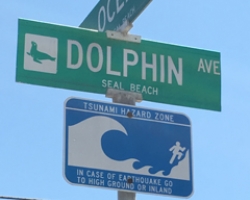
You’ve seen the blue and white signs around the beach and along Pacific Coast Highway. They are a warning: Seal Beach is in a tsunami hazard zone.
But would you know what to do if a tsunami was coming? And, more importantly, are you prepared for what happens after it hits?
September is the time to start answering these questions. It’s National Preparedness Month and this year’s theme is “Disasters Don’t Plan Ahead. You Can.” Whether it’s a tsunami, earthquake or flooding, the message isn’t to be scared; it’s to get prepared.
What you can do
Seal Beach Police Operations Administrative Sgt. Mike Henderson is urging everyone to take at least one affirmative step to plan for an emergency during National Preparedness Month. So what’s the best way to do that? “Sweat the small stuff so you’ll be ready for the big stuff,” said Seal Beach resident Jennifer Stewart-Tai, the owner of City Girl Prepper, a company specializing in emergency preparedness backpacks. She started the business after doing a training with the local Community Emergency Response Team, or CERT, around five years ago.
Stewart-Tai says many people feel overwhelmed by the task of preparing for an emergency so she suggests starting small by getting supplies together for an everyday disruption, like a power outage, and building from there. “What you do to prepare for that is the same process you do to prepare for the big one.”
Here are a couple of tips you can take this month to get prepared.
• Get a dedicated emergency water supply. The Federal Emergency Management Agency recommends storing at least 1 gallon of water per person in your household for drinking and sanitation. But 16-ounce plastic water bottles may not be your best option, according to Stewart-Tai. “Those have a very limited life span and may not be drinkable when the time comes.” There are other long-term water supplies available that can be kept from five to 50 years, she said.
• Create a household communication and reunification plan. When disaster strikes you may not be able to communicate with your loved ones. Pick an out-of-state contact for family members to check in with. It’s also important to agree on a meeting place in case you cannot go home. FEMA also recommends you establish how you will get emergency alerts. Sgt. Henderson suggests signing up for AlertOC, which sends automated emergency alerts to your home, cell, or business phone. Nixle is another alert system that sends texts or e-mails from emergency and law enforcement officials.
Create an emergency kit
ReadyOC.gov offers a printable checklist for what to include in your kit. You can also purchase pre-made kits. Once you do get your items together, Stewart-Tai recommends you make sure it’s all in one bag. According to Stewart-Tai, the advantage is having everything you need whether you stay where you are or need to evacuate.
If the task of preparing for an emergency seems overwhelming, Sgt. Henderson suggests starting a Neighbor 4 Neighbor program on your block. The program helps neighbors organize so they can pool resources to withstand and recover from a disaster.
What the city is doing
While you prepare at home, the city of Seal Beach is also taking big steps to enhance its emergency readiness. The city is updating its Emergency Operations Plan, something that hasn’t been done in five years, according to Henderson, who oversees Emergency Services for the city. Henderson said the new plan should be up for a vote at City Hall soon.
The city also received a grant from FEMA to develop a plan to identify hazards and create recommendations in how to better prepare for natural and human-made disasters. The grant will pay for the city’s first Local Hazard Mitigation Plan. Creating a FEMA-approved hazard mitigation plan will allow the city to apply for more FEMA funding to pay for preventive projects, such as retrofitting buildings to protect from earthquakes. Sgt. Henderson calls this “the next evolution in emergency planning” as FEMA is funding efforts to prepare for disasters, rather than solely aiding during the recovery from a catastrophe. The city is now looking to hire a consultant to develop the hazard mitigation plan and proposals are being accepted. The public will be able to take part in the hazard identification process, according to Sgt. Henderson.
For more information visit, www.sealbeachca.gov/Departments/Police/Public-Safety/Emergency-Disaster-Preparedness or www.ready.gov/september.



